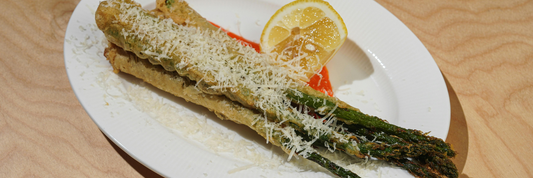The right ramen bowl can turn an ordinary meal into a restaurant-quality experience. Imagine steaming hot broth cradled perfectly, noodles swirling effortlessly, and toppings displayed beautifully—this is the power of the right bowl. Choosing the perfect ramen bowl isn’t just about size or material; it’s about enhancing flavor, maintaining heat, and elevating presentation. Whether you’re serving at home or running a busy restaurant, understanding the materials, shapes, and functional features of ramen bowls will transform the way you enjoy every slurp.
- How to Choose the Perfect Custom Paper Ramen Bowl for Your Brand
- How to Start a Ramen Noodle Business: Everything You Need to Know
-
Ramen Shop Checklist: Everything You Need Before Opening in Canada
Ramen Bowl Materials
Ceramic ramen bowl
Ceramic bowls are the most traditional choice for ramen. They offer excellent heat retention and durability. Glazed ceramic also resists stains and is easy to clean, making it a popular option for both home and restaurant use.


Is Ceramic Bowl Safe? How To Tell If Pottery Is Food Safe?
Porcelain ramen bowl
Porcelain bowls are smooth, elegant, and often used for presentation. They are lighter than ceramic and can feature intricate designs. Porcelain retains heat well, but thinner varieties may cool faster than heavy ceramics.
Melamine ramen bowl
Melamine is a durable, lightweight, and shatter-resistant material. It is ideal for casual dining or outdoor use. However, melamine does not retain heat as well as ceramic or porcelain and is not suitable for high-temperature applications like microwave use.

What Is Melamine Dinnerware? Is Melamine Dinnerware Safe with Dishwasher and Microwave?
Wooden ramen bowl
Wooden bowls offer a natural aesthetic and are lightweight. They are best for serving chilled ramen or dry noodle dishes. Heat retention is limited, and wooden bowls require careful maintenance to prevent warping and cracking.
Stainless steel ramen bowl
Stainless steel bowls are durable, lightweight, and resistant to breaking. They are easy to clean and often used in commercial kitchens. They retain heat moderately and are suitable for both hot and cold ramen dishes.
Eco-friendly ramen bowl materials (bamboo, sugarcane, cornstarch)
Eco-friendly bowls made from bamboo fiber, sugarcane bagasse, or cornstarch are biodegradable and compostable. They are lightweight and suitable for takeaway or casual dining. Heat retention is moderate, and some options may be single-use.
Pros and cons of each ramen bowl material
-
Ceramic: Excellent heat retention, durable; heavier and can break if dropped.
-
Porcelain: Elegant, lighter; may cool faster.
-
Melamine: Lightweight, durable; limited heat retention, not microwave-safe.
-
Wood: Lightweight, natural aesthetic; low heat retention, requires care.
-
Stainless steel: Durable, easy to clean; moderate heat retention, less traditional look
-
Eco-friendly: Sustainable, lightweight; moderate heat retention, sometimes single-use.
Ramen Bowl Sizes
Japanese ramen bowls come in a variety of sizes to suit different portion types and dining experiences. The ideal size typically ranges from 35 to 50 ounces, depending on the type of ramen and the servings you want to provide.
Standard ramen bowl size
For everyday home cooking and casual dining, a 35–40-ounce bowl is perfect for individual servings. It provides enough space for noodles, broth, and toppings without risking spillage. Standard bowls are versatile and easy to handle, making them suitable for most ramen recipes. Recommended options include classic designs like the Basket Weave Ramen Bowl, which balances depth and diameter for a comfortable eating experience.
Large ramen bowl size
If you want to serve generous portions or create a visually impressive presentation, a 50–60-ounce bowl is ideal. These larger bowls allow for extra toppings, hearty broths, and additional noodles, making them popular in restaurants or for specialty ramen dishes. A featured example is the Rustic Earth-Tone Ramen Bowl, which combines a wide mouth and deep base for maximum capacity and elegant presentation.
Small ramen bowl size for side dishes
Smaller bowls, typically 20–25 ounces, are great for lighter ramen portions, appetizers, or side dishes. They are ideal for tasting menus, kids’ servings, or noodle dishes with minimal broth. Small bowls are also convenient for multi-course meals where space and portion control are important.
Recommended ramen bowl size for home cooking
For home use, bowls in the 35–40-ounce range are usually the most practical. They are large enough to hold a satisfying serving but compact enough for easy handling and storage. Home cooks benefit from bowls that are versatile across different ramen styles, from miso and shoyu to vegetarian or cold noodle dishes.
Ramen bowl size for restaurants
Restaurants often opt for bowls 40–50 ounces to accommodate hearty portions and multiple toppings. The larger capacity enhances presentation and customer satisfaction while providing enough depth to prevent spills. Deeper bowls are especially useful for rich, brothy ramen like tonkotsu, while shallower bowls work well for styles like tsukemen, where noodles are dipped in concentrated broth rather than fully submerged.
When selecting a ramen bowl size, consider not only the volume but also the bowl’s depth and diameter. Deeper bowls hold more broth and toppings safely, while wider, shallower bowls allow for better presentation and easier access with chopsticks and spoons.
Not sure which sizes fit your brand? Get free consultation from our advisors here.
Ramen Bowl Shapes and Design Elements
Deep ramen bowl
Deep bowls hold more broth and toppings, preventing spills and allowing for layered presentation. They are ideal for rich, soupy ramen.
Wide-mouth ramen bowl
Wide-mouth bowls provide easy access for chopsticks and spoons. They also help cool hot ramen slightly faster for safer serving.
Thick-rim ramen bowl
Thick rims enhance durability, ease of handling, and heat insulation. They also provide a comfortable surface for sipping directly from the bowl.
Decorative patterns (waves, dragons, Japanese motifs)
Traditional and modern bowls often feature Japanese motifs such as dragons, waves, or floral designs. Decorative bowls enhance presentation, making ramen visually appealing in restaurants or social media posts.
Functional design aspects: heat retention, soup capacity, stability
Functional considerations include material thickness for heat retention, bowl shape for optimal soup capacity, and base stability to prevent tipping during serving or eating.

How to Choose the Best Ramen Bowl
Choosing a ramen bowl based on ramen style
The style of ramen you serve should directly influence the type of bowl you select. For rich, hearty broths like tonkotsu or miso, deep bowls are ideal as they can hold more liquid and toppings without spilling.
Wide and shallow bowls work best for lighter broths, such as shoyu or shio ramen, where the focus is on presentation and easy slurping. Small or narrow bowls are perfect for cold ramen dishes, dry noodles, or side portions, providing a visually appealing, compact serving. Matching bowl depth and width to your ramen style ensures a better eating experience and optimal presentation.

Choosing by capacity and volume
When selecting a ramen bowl, capacity and volume are critical factors that directly affect the dining experience. The bowl must be large enough to comfortably hold the noodles, broth, and toppings without overflowing, yet not so oversized that it feels awkward to handle.
- For home cooking, standard bowls with a capacity of 35–40 ounces are versatile and practical, accommodating most recipes while remaining easy to hold and store. These sizes work well for everyday meals, ensuring that broth stays warm and toppings are proportionate.
- For restaurant or commercial use, larger bowls in the 45–50-ounce range are preferred. They allow chefs to serve generous portions with multiple toppings, creating a satisfying and visually appealing meal for customers. Deep bowls in this capacity prevent spills and give diners enough room to enjoy every element of the dish.
- Smaller bowls, around 20–30 ounces, are suitable for side portions, appetizers, or tasting menus. They are perfect for sampling noodles, serving light broths, or offering smaller, controlled servings for children.
Heat retention and material durability
Materials affect both the longevity of the bowl and the quality of the ramen experience. Ceramic and porcelain bowls are excellent for heat retention, keeping broth warm throughout the meal.
They are also aesthetically pleasing and suitable for fine dining. Stainless steel and melamine bowls, on the other hand, are extremely durable and resistant to breaking, making them ideal for high-traffic restaurants or casual dining. When choosing a bowl, balance the need for heat retention against the environment in which the bowls will be used—ceramic for presentation, stainless steel or melamine for durability and convenience.
Price factors and quality indicators
Price is often tied to the material, craftsmanship, and brand. Heavy ceramic or fine porcelain bowls may be more expensive but offer longevity, premium feel, and better heat retention.
Mid-range options, such as melamine or eco-friendly disposable bowls, are cost-effective, lightweight, and suitable for casual dining, takeout, or outdoor events. When evaluating quality, check for smooth glazing, even thickness, non-porous surfaces, and heat tolerance, as these factors influence both durability and the dining experience.
Ramen bowl sets vs single ramen bowl
Deciding between sets and single bowls depends on usage and presentation needs. Ramen bowl sets are ideal for families, restaurants, or themed dining experiences, providing matching aesthetics and consistent portion sizes.
They also allow you to serve multiple dishes at once without worrying about mismatched bowls. Single ramen bowls offer flexibility for specialty dishes, seasonal menus, or experimental recipes, and are easier to mix-and-match for a unique table setting. Consider your menu, serving frequency, and storage space when making this decision.
FAQs About Ramen Bowl Guide
How big should a ramen bowl be?
A ramen bowl typically ranges from 800–1000 ml, with many restaurants preferring large 1.2–1.5L bowls.
What material is best for a ramen bowl?
Ceramic and porcelain offer the best heat retention and authenticity.
Can ramen bowls go in the microwave?
Most ceramic and porcelain bowls can; melamine usually cannot.
Why are ramen bowls so big?
They need space for broth, noodles, toppings, and mixing without spilling.
What shape is best for ramen?
Deep bowls with wide rims work best for maintaining temperature and accommodating toppings.
Conclusion
Selecting the right ramen bowl ensures that every bowl of ramen tastes and looks its best. By considering materials, size, shape, and functionality, you can enhance heat retention, presentation, and dining enjoyment. Whether for home cooking, casual dining, or professional restaurants, the right ramen bowl makes all the difference in delivering an authentic and satisfying ramen experience.




